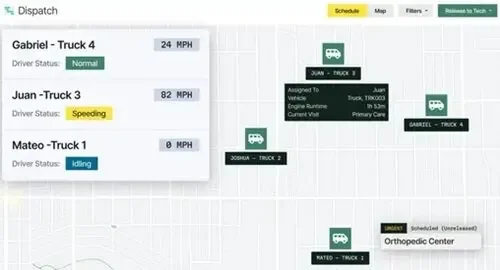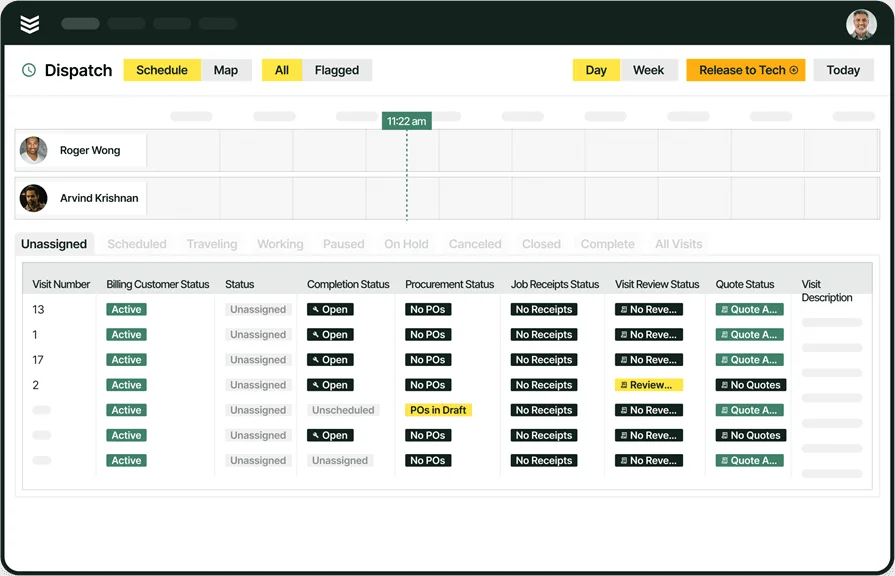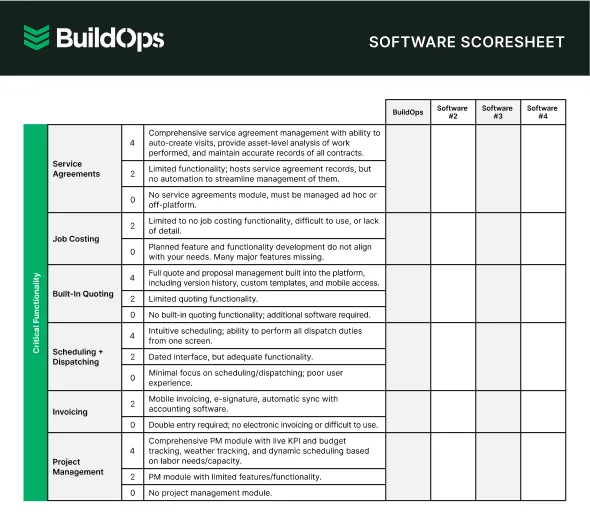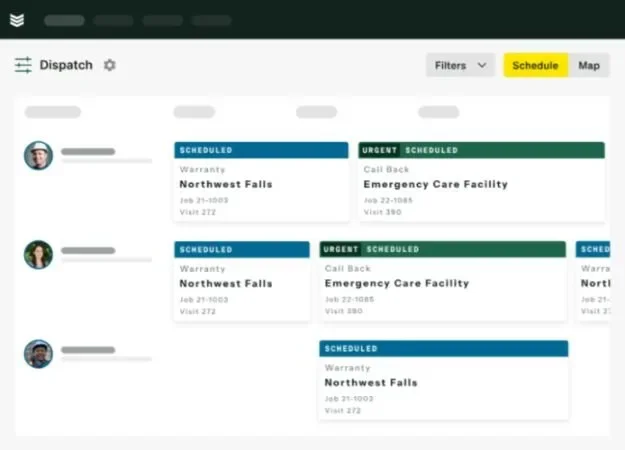When you're managing a crew in the field, there’s no room for guesswork. If schedules aren’t tight and dispatching falls apart, the whole operation slows down. That’s why getting your systems dialed in matters.
This guide breaks down exactly how to build, refine, and scale your processes so you can keep jobs moving, crews productive, and customers happy. We’ll cover real-world strategies that actually work—and show you where dispatching & scheduling software fits into making it all faster and easier. Whether you're fixing gaps in your current system or building one from scratch, this guide gives you a clear path forward. Here’s what we’ll cover:
- What’s the difference between scheduling and dispatching?
- Why dispatching and scheduling go hand-in-hand
- What goes into the scheduling & dispatching process?
- 8 dispatching and scheduling best practices for success
- Using dispatching and scheduling software
- Top 3 dispatching and scheduling software tools for contractors
Before we jump into best practices and tech solutions, it’s important to get clear on the basics. What exactly are we talking about when we say scheduling and dispatching? And why do both need to work hand-in-hand to keep your operation running like a well-oiled machine? Let’s break it down.
What’s the difference between scheduling and dispatching?
Scheduling organizes when and where work happens, matching the right techs to the right jobs at the right times. Dispatching kicks in when it’s time to move—making sure the scheduled jobs actually happen by guiding techs in real-time to each site. Both have to work together to keep jobs on track.
- Scheduling: Planning ahead by assigning jobs to techs based on availability, skills, location, and priority. It's about building the roadmap before the day even starts.
- Dispatching: The real-time act of getting techs where they need to go. It’s about communicating changes, confirming arrivals, and handling curveballs that pop up on the fly.
Think of scheduling as setting the plan and dispatching as executing it. A schedule can look great on paper, but without dispatchers keeping techs moving and adjusting for what’s happening in the field—traffic jams, emergency calls, no-shows—it falls apart fast. Both pieces have to click together to keep your team moving and customers happy.
Deep Dive
Make sure you’re equipped to combine scheduling and dispatching to manage projects with greater precision. We explore all there is to know in our guides: The Comprehensive Guide to Field Service Scheduling and Guide to Field Service Dispatching: Smarter Jobs, Less Chaos.
Why dispatching and scheduling go hand-in-hand
Scheduling and dispatching must work together because they both control how work gets assigned and completed. Scheduling organizes jobs based on available resources, technician skills, locations, and customer needs. Dispatching executes that plan in real time, adjusting for changes on the ground like delays, cancellations, or urgent calls. Without full coordination, even the best schedule can fall apart once the day begins.
When dispatching and scheduling are seamlessly integrated, you are maximizing every tech’s time, reducing gaps between jobs, handling emergencies faster, and completing more work without adding extra hours. Effective integration ensures your techs stay productive, your jobs stay on track, and your customers stay satisfied. This is why successful service operations always focus on both — not one or the other.
What goes into the scheduling & dispatching process?
Getting scheduling and dispatching right takes more than just filling in time slots. It means asking the right questions at every step to make sure your team, your resources, and your customers are fully accounted for.
- Technician availability and skills - Who is available based on today’s workload and open job tickets? Does the assigned tech have the certifications, parts, and equipment needed for the task? Are tech assignments being spread out fairly to avoid overworking key team members?
- Job priority and deadlines - Which jobs must absolutely be completed today versus those that can be pushed? How are emergency or urgent service calls being prioritized and added to the schedule? Are there controls in place to reevaluate deadlines when customer needs shift?
- Geographic logistics - Are technicians being routed to minimize travel time between job sites? Are service areas and zones divided efficiently to cut down on back-and-forth trips? How are last-minute cancellations or reroutes affecting the day’s travel plans?
- Resource and equipment checks -Are vehicles inspected, fueled, and ready before technicians head out for the day? Are techs fully equipped with the right parts and tools before reaching the job site? Is there a process to quickly replace or repair broken equipment without delaying jobs?
- Real-time communication and updates - How are dispatchers updating technicians about scheduling changes in the field? What system is in place to alert customers about delays or tech ETAs? Are dispatchers getting real-time feedback from techs to adjust schedules on the fly?
Before you can fine-tune your dispatching and scheduling systems, you need a clear view of how each moving part fits together. Now that we’ve outlined what to watch for, let’s dive into the best practices that separate solid operations from chaotic ones.
What does a successful dispatcher do?
A successful dispatcher keeps field operations running smoothly by connecting the schedule with what’s actually happening on the ground. They monitor jobs, adjust for delays, communicate with techs and customers, and make quick decisions to keep the day moving.
The best dispatchers don’t just react—they work from a strong process built around speed, clarity, and field visibility. Resources like a field service dispatching guide can help sharpen these skills, while field technician dispatch software gives dispatchers real-time tools to manage technicians, reroute jobs, and handle shifting priorities without missing a beat.
What does a successful scheduler do?
A successful scheduler keeps the whole operation balanced by matching the right techs to the right jobs at the right times. They manage shifting priorities, customer demands, and real-world delays without letting the schedule fall apart.
Great schedulers think strategically—looking ahead, spotting gaps, and adjusting fast when needed. A strong field service scheduler plays a key role in building daily plans, making quick decisions on the fly, and ensuring every tech’s time is used as efficiently as possible.
How to implement and iterate your dispatching and scheduling process
Building a reliable scheduling and dispatching system starts with understanding how every piece fits into your overall operation. It’s not just about setting appointments—it’s about managing resources, handling shifting priorities, and keeping crews moving without bottlenecks.
Taking time to map out a full field service management process workflow gives you the framework you need. From there, you can build a system that adapts, grows, and keeps pace with the demands of the job. Here’s how to set it up the right way:
- Define clear goals - Set specific targets like faster response times, higher job completion rates, or better technician utilization so you know exactly what you’re working toward.
- Map out your current process - Document how service requests are handled today to expose delays, miscommunications, and resource gaps that slow down your field team.
- Pick the right scheduling and dispatch software - Select a platform that matches how your teams actually work, handles real-time job changes, and provides full visibility into scheduling.
- Train your team on new processes - Get dispatchers, schedulers, and techs up to speed on changes so they can act faster, handle updates confidently, and deliver better results.
- Monitor performance and adjust regularly - Track critical metrics like job timing, technician movement, and customer satisfaction to find areas where improvements are needed.
- Establish real-time communication loops - Build strong communication between dispatchers and field techs to make faster adjustments when schedules shift or emergencies happen.
- Use feedback from the field - Regularly gather feedback from your technicians and dispatchers to spot workflow issues early and keep your system running efficiently.
- Revisit and refine scheduling rules - Look at your scheduling logic every few months to see if workload balancing, travel routing, and job prioritization are still aligned with business needs.
To stay competitive, you need to keep sharpening how your team moves, responds, and delivers. Let’s break down the best practices that help top contractors keep their operations running tight.
8 dispatching and scheduling best practices for success
Running a tight operation doesn’t happen by accident. It takes building habits and systems that make scheduling and dispatching faster, smarter, and more reliable. The following best practices are what top contractors rely on to keep jobs flowing and crews productive without wasting time or resources.
1. Prioritize urgent jobs first
Not all jobs carry the same weight. Emergency repairs, critical service calls, and VIP clients must move to the top of the list. Building urgency tiers into your scheduling system helps dispatchers react fast without scrambling. Set clear guidelines for what counts as urgent, and make sure the team knows how to rearrange the day when these calls come in. Customers notice when you're the contractor that shows up first when it matters most.
2. Balance technician workloads
Even your top technicians will burn out if they’re overloaded day after day. Balancing workload across your entire field team makes sure every tech stays sharp, motivated, and available when it counts. Look at skills, geography, and job complexity—not just the number of work orders—to distribute assignments fairly. Schedulers who manage loads smartly end up keeping more techs long-term and building a stronger bench of trusted field staff.
3. Standardize your scheduling process
If every dispatcher handles the work differently, mistakes pile up fast. Build one clear, documented process that everyone follows for assigning jobs, adjusting routes, and updating customers. A strong field service management platform can help you automate steps and track every job the same way. Standardization cuts down human error, saves time on training new team members, and gives leadership a clear view of what's happening day to day.
4. Stay flexible with mobile updates
Schedules rarely survive the first punch from the real world. Traffic jams, broken equipment, and emergency calls will always throw a wrench into the plan. Giving your techs and dispatchers mobile access to job updates means the schedule stays live, not frozen at 8 a.m. With the right field service mobile workforce management, you can update assignments, push notifications, and reroute techs in real time without dragging everyone back to the office.
5. Track and learn from scheduling trends
Your scheduling data holds the keys to working smarter. Analyze patterns like peak demand seasons, common job durations, high-cancellation times, and average travel distances. Use this data to adjust staffing levels, pre-schedule maintenance during slow seasons, and get ahead of demand spikes. Following the latest field service management trends shows you how top contractors are using real-world numbers to plan better—not just guess.
6. Connect scheduling with invoicing
If jobs are completed but invoicing gets delayed, money is left sitting on the table. Connect your scheduling system directly to your billing process so that the moment a tech closes out a job, invoicing kicks off automatically. Linking the two workflows minimizes paperwork, cuts billing errors, and speeds up cash flow. Tools like scheduling and invoicing software make it easier to tie every finished job directly to revenue without relying on manual steps.
7. Keep dispatch and customer communication tight
Customers hate being left in the dark. A missed update or a late arrival without warning can do more damage than the job issue itself. Great dispatchers send real-time updates, confirm ETA changes, and follow up when jobs are complete. Even a short "on the way" text builds trust. Making communication part of your dispatch workflow helps protect customer relationships and turns one-time jobs into repeat business.

Dispatch techs efficiently
Simplify dispatching so the right tech for the project arrives at the job site.
8. Review dispatch performance regularly
You can't fix what you don’t measure. Regularly review dispatch metrics like average response time, reroute rates, and job reassignments to spot weaknesses early. Meet with dispatchers and schedulers regularly to talk through challenges and tweak processes where needed. Using strong contractor dispatch management systems makes it easier to pull real performance data instead of relying on gut feeling. Consistent reviews lead to a team that keeps getting sharper and faster over time.
Using dispatching and scheduling software
Keeping up with customer demand, technician schedules, and unexpected changes in the field gets harder every year. Manual processes can’t keep pace with the real-world speed contractors need to run a profitable operation.
That’s where dispatching and scheduling software steps in—giving businesses the tools to manage jobs smarter, faster, and with a lot less stress. If you want to stay ahead, it’s not about working harder—it’s about working smarter with systems that support your team at every step.
Benefits of using dispatch and schedule software
The right software doesn't just speed things up—it helps the whole business run smoother from job intake to invoicing. Here’s how scheduling and dispatching software drives real results:
- Faster job scheduling and crew assignments - Dispatching and scheduling software makes it easy for office staff to assign jobs in minutes instead of hours. With better calendar views, drag-and-drop scheduling, and automated reminders, crews stay on task without confusion. Using field service scheduling tools cuts the downtime between calls and keeps the workday packed with completed jobs.
- Better field-to-office communication - Strong dispatch software bridges the gap between techs in the field and teams at the office. Updates on delays, job progress, and emergency calls happen in real time without endless check-ins. Platforms built around field service management features help everyone stay on the same page—and adjust jobs quickly when the unexpected happens.
- Improved customer experience - Customers expect fast updates, accurate arrival windows, and clear communication when they book a service call. Scheduling and dispatching software automates appointment reminders, arrival notifications, and status updates—cutting down on frustration and boosting customer satisfaction. Systems with built-in dispatch management give your contractors and crew an even tighter grip on client communications.
- Reduced scheduling errors and missed jobs - Manual scheduling leaves a lot of room for mistakes—missed time slots, double bookings, or forgotten appointments. Software brings structure to the chaos with visual calendars, conflict detection, and auto-assign features that stop problems before they happen. Leveraging field service management tools means your schedule stays tight and predictable—even when the workload spikes.
- Optimized technician workloads - Balancing workloads across your team isn’t easy without visibility. Scheduling and dispatching software gives managers real-time insight into each tech’s skills, assignments, and availability—making it simple to spread jobs fairly. This leads to happier techs, less burnout, and better results across the board.
- Quicker job closeouts and invoicing - Once a tech finishes a job, the billing process should kick off automatically—not days later. Tying dispatch, scheduling, and invoicing together shortens the time between work completion and payment. It also speeds up maintenance scheduling, follow-ups, and customer communications without dragging down your office team.
- Scalable operations for growing businesses - As your company lands more contracts and services more sites, manual systems fall apart. Scheduling and dispatching software makes it easier to add new techs, tackle bigger projects, and handle extra work without drowning in paperwork. A strong system lets your team manage heavier workloads without missing deadlines or hurting service quality.
5 dispatching and scheduling software features to look for
Not all scheduling and dispatching tools are created equal. Some systems come packed with bells and whistles you’ll never use—what matters is finding the features that actually solve the challenges your crews face every day. If you want a system that keeps operations running smoothly, these are the five features you can’t afford to skip.
- Real-time mobile access for technicians - Your technicians need updates while they're in the field, not just at the start of the day. A mobile app connected to your scheduling software lets techs receive job changes, new assignments, and customer updates instantly. Using a field service technician mobile app keeps field teams productive and responsive without constant calls back to the office.
- Service agreement management - Managing recurring service contracts manually wastes time and leads to missed appointments. Scheduling and dispatch platforms with built-in service agreement software automate these tasks, making sure maintenance visits and contract work get scheduled automatically—without anything slipping through the cracks.
- Integrated customer management - Scheduling software should also store critical customer information like service preferences, access restrictions, and job history. A strong construction CRM makes it easier for dispatchers and technicians to deliver faster, more personalized service without digging through disconnected systems.
- Automated quoting and invoicing - Tying quoting and billing into your scheduling system helps speed up cash flow and keeps projects moving. Look for solutions that integrate construction quoting software and field service invoicing to automatically trigger follow-up steps the moment a job is complete.
- Vehicle and technician tracking - Knowing where your vehicles and techs are at any moment helps dispatchers optimize routing, avoid traffic, and manage field operations smarter. A fleet management system connected to scheduling ensures crews stay on the move—and jobs stay on schedule.
Expert Tip
Our all-in-one FSM software solution connects professionals with a suite of tools that help them execute their jobs. While we have a comprehensive suite of tools to make this possible, anything we don’t have built-in can be easily added through available integrations.
Picking the best platform for your business depends on how well it fits the way your team actually works. Let’s look at the top dispatching and scheduling software options that are helping contractors stay ahead in the field.
Top 3 dispatching and scheduling software tools for contractors
Finding the right dispatching and scheduling software comes down to picking a platform that matches the way your business runs day to day. Some tools fit bigger commercial crews, while others handle smaller residential work better. Here’s a breakdown of top options depending on where you focus your services.
1. Best for commercial contractors: BuildOps
BuildOps was designed specifically for commercial contractors who need serious scheduling and dispatching power. It combines job management, technician scheduling, dispatch, customer management, and quoting all in one system. BuildOps handles multi-day projects, recurring service contracts, emergency calls, and everything in between—without the chaos or bottlenecks that slow teams down.
Why this is best for commercial: BuildOps is built for bigger jobs, complex work orders, and teams that need real-time control across multiple projects, not just simple single-day service calls.

Streamline scheduling and dispatch
Make sure field techs always arrive at the right job site on time.
2. Best for residential contractors: Housecall Pro
Image Source: Housecall Pro
Housecall Pro works well for residential contractors who need basic scheduling, dispatching, and payment processing without heavy operational complexity. It’s easy to use, offers online booking, customer texting, and simple invoicing—which makes it a solid fit for small teams focused on speed and convenience. However, Housecall Pro may feel limiting for contractors handling larger commercial jobs or operations that demand more complex workflows.
Why this is best for residential: It simplifies daily residential service work and gives techs easy-to-use tools without the need for complicated systems.
3. Best for general contractors: Jobber
Image Source: Jobber
Jobber offers a flexible setup for contractors handling a mix of residential and light commercial jobs. It covers scheduling, quoting, invoicing, and CRM functions in a clean interface that smaller teams can manage without a full-time admin. Jobber is a strong pick for general contractors that need structure without overwhelming their operations. However, it may not scale easily for contractors who grow into heavy commercial service work or need deeper customization.
Why this is best for general contractors: Jobber balances features and ease of use for businesses that handle diverse service types but don't require highly specialized commercial service capabilities.

Easily compare software options
Guide your search for schedule and dispatch software with our simple scoresheet.
Effective dispatching and scheduling requires more than simply arranging jobs on a calendar. It involves optimizing every aspect of your field operations for enhanced efficiency and seamless execution. Balancing technician workloads and adapting to unexpected challenges are crucial for success, and implementing the right processes and tools can significantly impact your outcomes.
The features we walked through—real-time field updates, service agreement automation, CRM connections, faster invoicing, and fleet tracking—aren't standard in most scheduling software. Many systems cover one or two pieces well, but few give you a complete package. That’s where BuildOps stands out. It ties everything together in one platform built specifically for commercial field service teams—giving you visibility, control, and the ability to grow without patching together disconnected tools.

Take a closer look at BuildOps
Eliminate guesswork, keep schedules in sync, and finish jobs on time.










